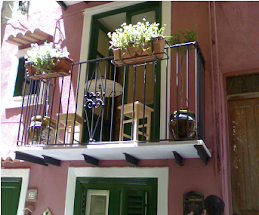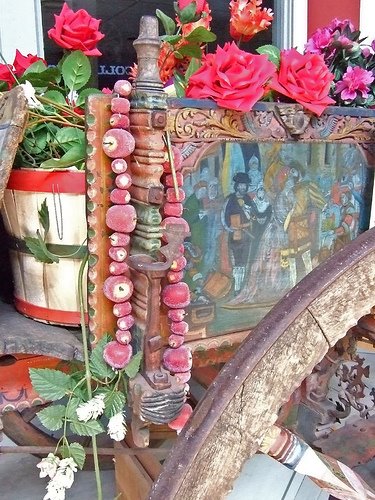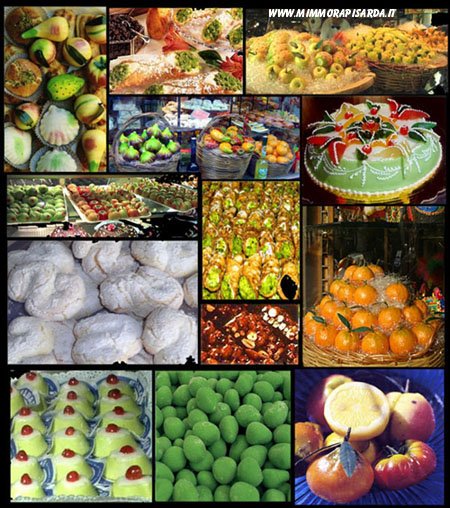
Source: The New York Times
Couscous, the dish of steamed wheat grains most readily identified with the countries of North Africa, belongs to Sicilian tradition as well. Until recently, though, its elaborate preparations were undertaken only to mark some special occasion.
I first tasted Sicilian couscous about 30 years ago, when a childhood friend of my husband's who had emigrated to the States brought his small daughter back to visit his native land. His former schoolmates celebrated his return with couscous, prepared by their wives and served up at my in-laws' beach house.
We wives labored at length under the direction of another friend's mother, former chef to an aristocratic household in Trapani. A small, stout woman in black, she arrived midmorning, wedged into her daughter-in-law's minuscule Fiat amid bags of couscous, branches of bay leaves and crates of assorted fish balanced on stacks of ceramic platters and bowls. Cradled on her lap was a huge aluminum couscoussiera, a double boiler in which the tight-fitting upper pot is perforated like a colander. She was an exacting taskmaster and I was a hopeless novice, but for however little I contributed to the making of the couscous, I more than compensated in the eating of it.
In those days couscous was something of a clandestine affair. It was not easy to find it outside the area of Trapani, Sicily's westernmost province, or anywhere but private houses. Relatively few restaurants served it regularly, and few people outside Sicily suspected its existence. But now that the world has discovered Sicilian cuisine, the word is out, and many foodies arrive with couscous inscribed on their lists of dishes to taste while on the island. Although the Trapani region maintains its near monopoly, today there are a number of good restaurants there that include couscous on their daily menu.
That couscous is an immigrant from the Maghreb, or northwest Africa, is beyond doubt. Its origins are Berber, but just when it made the leap from North Africa to Sicily is a matter of debate. One school of thought believes that couscous arrived with the Saracen invasion in A.D. 827, and lingered after the 250-year Arab occupation ended, while other food historians claim that it was introduced (or reintroduced) only in the 19th century.
Couscous grains appear, however, on the price control lists of the Palermo markets during the 15th and 16th centuries, and the 1694 Christmas Day menu for the nuns of the San Salvatore Monastery in Palermo included a couscous dessert, similar perhaps to the pistachio-flavored cuscus dolce still made today by the nuns at the Spirito Santo abbey in Agrigento.
However long it has been here, the couscous that is served today in the homes and the restaurants of the Trapani area has evolved in its own particular fashion. In the first place, it is almost always served with fish, as opposed to the meat or vegetable versions characteristic of the Maghreb, and the rituals of preparation differ as well.
The proper Trapanese housewife disdains the precooked variety for the unprocessed, and sets great store by her ability to execute the 'ncocciata: swirling the rough-ground semolina grains around with one hand in a wide ceramic basin called a mafaradda, she uses the other hand to sprinkle it with just enough water so the individual grains gather into loose but not lumpy clusters.
Then the couscous, seasoned with a little olive oil, salt and pepper, is steamed over water rather than broth. Once cooked, the couscous is turned out into a large bowl, the fish broth is ladled over it, and then the bowl is wrapped in blankets and left to stand for half an hour, while the grains absorb the broth.
Within this general scheme there are many variations: our friend's mother used to line the upper part of her couscoussiera with bay leaves before she put the couscous in; a cousin remembers toasted almonds sprinkled on top; another friend claims that a pesto of garlic and blanched almonds added to the fish broth as it simmers is essential for an authentic couscous, and she adds that the broth must be made of 14 varieties of fish and shellfish.
Although Sicilians use spices much more sparingly than the North Africans, cinnamon gave a distinctive flavor to some couscous dishes that I have eaten in Sicily, while cloves were a distinctive note in a couscous that I recently ate at Alla Kasbah in Mazara del Vallo. This is a pleasant restaurant, only a few steps from the new museum that houses "The Dancing Satyr," a classical Greek statue in bronze that was recently swept up in the nets of a local fishing boat.
Here, perhaps because Mazara is a town with a very large North African population working on its fishing fleet and in its vineyards, the couscous is quite reminiscent of its African forefathers. It comes amply surrounded by fish (there is also a meat version) and is a meal in itself, especially if preceded by the house antipasto, which includes a miniature Tunisian brik, a fried egg pancake with a potato-and-tuna filling.
Elsewhere it is more common to serve couscous, accompanied by just a few morsels of fish, as a first course to take the place of pasta. That is what we were given at the Trattoria Garibaldi in the wine-producing city of Marsala, just north of Mazara, where we went in search of what is reputed to be the best couscous in the region. The crowd there that August evening bore witness: the tables spilled out the door and filled the small piazza squeezed between a Baroque church facade and the crenellated wall of the Renaissance town hall. The couscous itself was very good - straightforward, not particularly spicy but perfect in texture and balanced in seasoning.
I have a particular fondness for eating couscous at the Ristorante Monte San Giuliano in Erice, where it is served with fish broth on the side to add as you like. This enthusiasm is perhaps fanned by my love for this little medieval town, which crowns a solitary mountain overlooking the port of Trapani and beyond to the Egadi Islands.
I have had the good fortune to watch the San Giuliano chef, Matteo Giurlanda, do a couscous demonstration, to admire the dexterity necessary for a proper 'ncocciata and to see how he seals the two layers of the couscoussiera with a flour-and-water paste so the steam will not escape. Little rings of the same paste are placed on top of the couscous while it steams: when they are fully cooked, so is the couscous. According to his headwaiter and partner Andrea Coppola, these rings were once the first taste of festivity for the small children of the household.
It is not necessary for the curious to go farther afield to compare the Sicilian variety to the North African original. In recent years numerous restaurants have been opened by immigrants from the southern shores of the Mediterranean. The Trattoria Amilcar in Palermo, for example, offers couscous and other authentic Tunisian dishes that are as good if not better than many that I have eaten in Tunisia itself.
Finally, for the truly obsessed, the lighthouse on the rocky tip of northwestern Sicily is a beacon. It illuminates the pretty little fishing village of San Vito lo Capo, which celebrates the end of the summer with an annual international couscous festival, held during the third week of September. Each country sends a team of chefs who dish out their national couscous specialty to throngs of visitors and, on the final evening, to the international jury whose happy job it is to pick the winner.
Restaurant Information
An expensive wine or fish course will increase these prices considerably.
Ristorante Alla Kasbah, Via Itria 10, Mazara del Vallo; telephone (39-0923) 906126. Closed Monday. $30 to $38 a person, including wine, at $1.25 to the euro.
Trattoria Garibaldi, Piazza Addolorata 35, Marsala; (39-0923) 953006. Closed Saturday lunch and Sunday dinner; $30 to $38 a person, including wine
Ristorante Monte San Giuliano, Vicolo San Rocco 7, Erice; (39-0923) 869595. Closed Monday. $30 to $35 a person, including wine.
Trattoria Pizzeria Amilcar, Via G. Marconi 9, Palermo; (39-333) 1909238. Closed Tuesday. $25 to $30 a person, including wine.
Information about the annual Couscous Fest at San Vito lo Capo can be found at http://www.sanvitocouscous.com/.
 My Grandma Providenza's only job was that of raising her three, extremely spoiled, children and she used to spend entire days in the kitchen. I can still recall the delicious aromas, when she was organising her usual Sunday gathering, right after mass.
My Grandma Providenza's only job was that of raising her three, extremely spoiled, children and she used to spend entire days in the kitchen. I can still recall the delicious aromas, when she was organising her usual Sunday gathering, right after mass.











